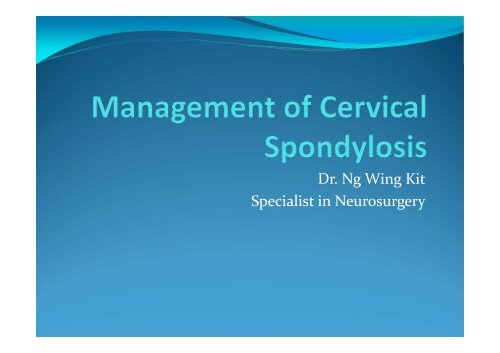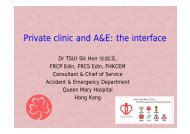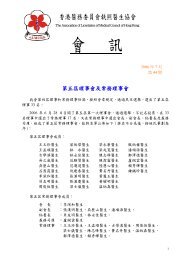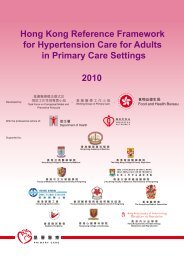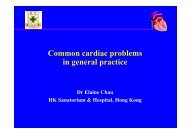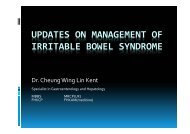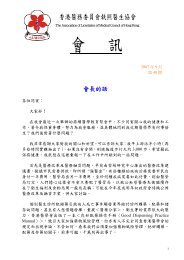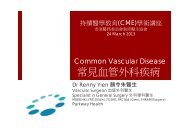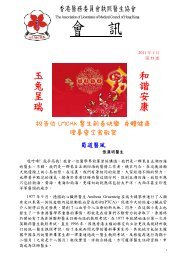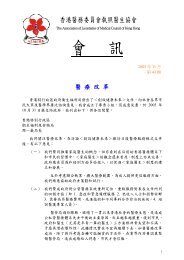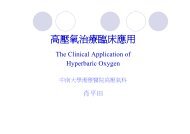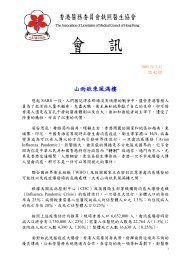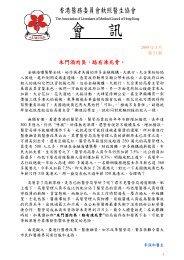Dr. Ng Wing Kit Specialist in Neurosurgery
Dr. Ng Wing Kit Specialist in Neurosurgery
Dr. Ng Wing Kit Specialist in Neurosurgery
You also want an ePaper? Increase the reach of your titles
YUMPU automatically turns print PDFs into web optimized ePapers that Google loves.
<strong>Dr</strong>. <strong>Ng</strong> <strong>W<strong>in</strong>g</strong> <strong>Kit</strong><br />
<strong>Specialist</strong> <strong>in</strong> <strong>Neurosurgery</strong>
How common is it?
Neck pa<strong>in</strong><br />
• Incidence 14‐17%<br />
• 23 cases per 1000<br />
• More common <strong>in</strong> females<br />
• Resolution less common with advanc<strong>in</strong>g age.
Cervical radiculopathy<br />
• Much less common than neck pa<strong>in</strong><br />
• Incidence 3.3 cases per 1000<br />
• Commoner <strong>in</strong> females<br />
• 4 th and 5 th decades
Cervical myelopathy<br />
• Less well def<strong>in</strong>ed<br />
• Common cause of sp<strong>in</strong>al cord dysfunction <strong>in</strong> elderly<br />
• Ossification of posterior longitud<strong>in</strong>al ligament (OPLL)<br />
high prevalence <strong>in</strong> Japanese
Anatomy<br />
Biomehanics
Cervical sp<strong>in</strong>e anatomy<br />
• 7 Segments<br />
• Superior 2 segments be<strong>in</strong>g<br />
specialised structures:<br />
atlas (C1) and axis(C2)<br />
• Spondylosis more<br />
common <strong>in</strong> subaxial<br />
cervical sp<strong>in</strong>e (C3‐C7)
C1/2 complex
Cervical sp<strong>in</strong>e anatomy
Intervertebral disc
Pathophysiology
Disc change with age<br />
•Chondrocyte proliferation<br />
•Mucous degeneration<br />
•Cell death<br />
•Tear and cleft formation<br />
•Granular changes
Disc degeneration<br />
• Nutritional factors<br />
• Genetic factors<br />
• Mechanical factors
Disc degeneration results <strong>in</strong> micro<strong>in</strong>stability<br />
•Disc bulg<strong>in</strong>g and hyperostosis<br />
reaction lead<strong>in</strong>g to osteophyte<br />
formaiton<br />
•Ligamentous hypertrophy
Micro‐<strong>in</strong>stability causes facet<br />
hypertrophy
Neck pa<strong>in</strong><br />
Cervical radiculopathy<br />
Cervical myelopathy
Neck pa<strong>in</strong>‐possible pa<strong>in</strong> generators<br />
• Muscular and ligamentous orig<strong>in</strong><br />
• Intervertebral disc<br />
• Facet jo<strong>in</strong>t degeneration<br />
• Non‐specific
Spondylotic syndrome<br />
• Recurrent neck pa<strong>in</strong><br />
• Aggravate with motion<br />
• Position dependent<br />
• Arm and shoulder pa<strong>in</strong> (non‐radicular)
Spondylotic syndrome<br />
• Night and early morn<strong>in</strong>g pa<strong>in</strong><br />
• Vertigo and dizz<strong>in</strong>ess<br />
• Vegetative symptoms<br />
• headaches
Ergonomics
Cervical radiculopathy<br />
• Disc herniations<br />
• Spondylolytic change
Disc herniations
Spondylotic radiculopathy
Cervical radiculopathy<br />
• Radicular pa<strong>in</strong><br />
• Sensory disturbances<br />
• Motor weakness<br />
• Reflex deficits
Exam<strong>in</strong>ation f<strong>in</strong>d<strong>in</strong>gs<br />
• Sensory deficit<br />
• Motor deficit<br />
• Reflex deficit
Special tests<br />
• Spurl<strong>in</strong>g test<br />
• Shoulder abduction or depression test<br />
• Axial traction test
Spurl<strong>in</strong>g test
How good are these tests?
Myelopathic syndrome<br />
• Numb, pa<strong>in</strong>ful, clumsy hands<br />
• F<strong>in</strong>e movement<br />
• Balance and gait<br />
• Very often together with spondylotic syndrome
Exam<strong>in</strong>ation f<strong>in</strong>d<strong>in</strong>gs<br />
• Atrophy of small muscles<br />
• Gait disturbances and ataxia<br />
• Spasticity, hyperreflexia, and clonus<br />
• Sensory and vibratory deficits<br />
• Muscle weakness<br />
• Lhermitte sign
Neck pa<strong>in</strong><br />
Radiculopathy<br />
Myelopathy
Neck pa<strong>in</strong><br />
• Most cases of acute neck pa<strong>in</strong> resolve with<strong>in</strong> a few days<br />
• For patients with neck pa<strong>in</strong> at basel<strong>in</strong>e:<br />
• Persistent and recurrent neck is however not<br />
uncommon<br />
• 10% will have aggravation<br />
• Lack of radiological correlation
Cervical radiculopathy<br />
• Disc herniation decrease <strong>in</strong> size with time <strong>in</strong> 1/3 of<br />
patients, particularly <strong>in</strong> disc migration<br />
• 90% of patients become asymptomatic or mildly<br />
<strong>in</strong>capaciated
Cervical myelopathy<br />
• Once diagnosed almost never recovered to normal<br />
(Clark and Rob<strong>in</strong>son)<br />
• 75% episodic worsen<strong>in</strong>g with stability <strong>in</strong> between<br />
• 25% slow steady progression<br />
• 5% rapid progression
Cervical myelopathy<br />
• Patient with symptoms of more than 2 years showed<br />
no improvement<br />
• In OPLL, m<strong>in</strong>or trauma can cause acute deterioration<br />
• For <strong>in</strong>dividual patient, cl<strong>in</strong>ical course is variable
Neck pa<strong>in</strong><br />
Radiculopathy<br />
myelopathy
Neck pa<strong>in</strong><br />
• Non operative treatment is the ma<strong>in</strong>stay of therapy<br />
• Pathomorphological correlate is unreliable
Neck pa<strong>in</strong><br />
• Physical therapy<br />
• Oral medications: NSAIDs, muscle relaxant, analgesics<br />
• Sp<strong>in</strong>al <strong>in</strong>jections<br />
• RF ablations for facet jo<strong>in</strong>t pa<strong>in</strong>
Cervical radiculopathy<br />
• In absence of motor deficit, non‐surgical management<br />
should be tried first<br />
• Traction<br />
• Transforam<strong>in</strong>al epidural <strong>in</strong>jection<br />
• Safety concern
Cervical myelopathy<br />
• Unlikely to cause improvement
Neck pa<strong>in</strong><br />
Radiculopathy<br />
Myelopathy
Neck pa<strong>in</strong><br />
• Surgery for neck pa<strong>in</strong> alone is rarely <strong>in</strong>dicated<br />
• Need throughout <strong>in</strong>vestigation to identify source of<br />
pa<strong>in</strong><br />
• C1/2 lesions
Cervical radiculopathy‐<strong>in</strong>dications<br />
for surgery<br />
• Progressive, and functional motor deficit<br />
• Def<strong>in</strong>itive evidence of nerve root compression<br />
• Concordant symptoms and signs<br />
• Persistent symptoms despite non‐surgical treatment
Cervical myelopathy‐<strong>in</strong>dications for<br />
surgery<br />
• Progressive myelopathy<br />
• Acute deterioration with progression of deficit<br />
• Def<strong>in</strong>itive cord compression with myelopathic<br />
symptoms<br />
• Progressive deformity with deficits
Anterior sp<strong>in</strong>al fusion (ASF)<br />
Lam<strong>in</strong>ectomy<br />
Lam<strong>in</strong>ectomy with <strong>in</strong>strumentaiton and fusion<br />
Lam<strong>in</strong>oplasty<br />
Posterior foram<strong>in</strong>otomy<br />
Cervical total disc arthroplasty
Surgical considerations<br />
• Anterior or posterior?<br />
• Fusion or non fusion?<br />
• Instrumentation ?
Anterior sp<strong>in</strong>al fusion<br />
• Rob<strong>in</strong>son‐Smith<br />
• Cloward procedure<br />
• Gold standard <strong>in</strong> treatment of Cervical disc disease<br />
• High fusion rate for 1 level, decreases as no. of level<br />
goes up
Anterior diskectomy
Fusion choices<br />
• Tricortical bone graft<br />
• Cage: Titanium, PEEK<br />
• +/‐ plat<strong>in</strong>g
Lam<strong>in</strong>ectomy and fusion<br />
Rigid fixtion to prevent<br />
deformity
Lam<strong>in</strong>oplasty<br />
•Motion preserv<strong>in</strong>g<br />
•Less kyphotic deformity
Posterior Foram<strong>in</strong>otomy
Posterior foram<strong>in</strong>otomy
Cervical artificial disc replacement<br />
• ASF gold standard for Cervical disc pathology<br />
• Concerns about adjacent segment degeneration<br />
• Radiologically segments adjacent to fused level are<br />
more likely to degenerate
Cervical artifical disc replacement<br />
• Try to address the problem of motion preservation<br />
• Prevent adjacent segment degeneration<br />
• Sofar outcome of TDR are not <strong>in</strong>ferior to ASF
Case illustration<br />
• YWT<br />
• 40/F<br />
• Dizz<strong>in</strong>ess and left C6 radiculopathy<br />
• Cl<strong>in</strong>ically no muscle wast<strong>in</strong>g<br />
• Spurl<strong>in</strong>g +ve
MRI
Cervical total disc arthroplasty
Postoperative<br />
• Improved left sided numbness<br />
• Dizzness persists!<br />
• Repeated Xray FU motion preserved
Conclusions<br />
• Cervical spondylosis is common<br />
• Ma<strong>in</strong>stay of treatment for neck pa<strong>in</strong> alone is nonsurgical<br />
• Surgery has significant role <strong>in</strong> treatment of cervical<br />
radiculopathy and <strong>in</strong> particular myelopathy


